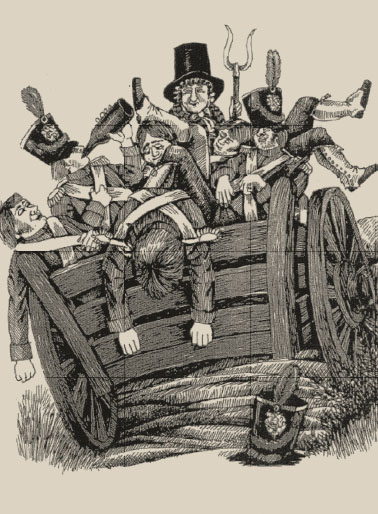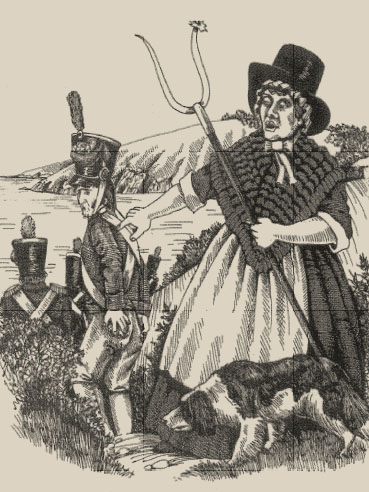
[caption id="OfCabbages&Kings_img1" align="aligncenter" width="90"]

GREAT BRITISH HEROES – #1
The Story of Jemima Nicholas
WHILE INVASIONS OF BRITAIN have been an intermittent occurrence since the time of Stonehenge’s construction at least, the last invasion of the island took place on February 22, 1797. It seems that a French fleet comprising some 1,400 Napoleonic troops was planning to attack Bristol, but got blown off course and landed in Fishguard Bay.
The French warships off-loaded men and arms and sailed away. Napoleon’s best being occupied elsewhere in Europe, the apparently ragtag collection of soldiers and jailbirds promptly neglected any military discipline and began a looting spree of the surrounding area. A mounted messenger was hurriedly sent to summon the Pembrokeshire Yeomanry to come to the rescue.
[caption id="OfCabbages&Kings_img2" align="aligncenter" width="378"]

WEIDER HISTORY GROUP ARCHIVE
Meanwhile, as the French soldiers were drinking themselves into bleariness, Jemima Nicholas, the wife of a Fishguard shoemaker, called all the local women and girls together, dressed in their traditional Welsh dress of black skirts, red shawls and tall black felt hats. Armed with axes, pitchforks, hoes and other tools, they lined the cliff tops surrounding Fishguard Bay. Against the fading daylight, the French thought the Welsh women were British soldiers. When the local militia arrived, the French troops, too drunk to fight, surrendered as prisoners of war. In the process, Jemima Nicholas herself, armed only with her pitchfork, single-handedly rounded up at least a dozen Napoleonic soldiers and put them in the Fishguard jail.
[caption id="OfCabbages&Kings_img3" align="aligncenter" width="369"]

WEIDER HISTORY GROUP ARCHIVE
A memorial to Jemima Nicholas pays tribute in St. Mary’s Church, Fishguard, where she is buried, and she has long been a heroine of local legend in southwest Wales. No documentary evidence of Jemima had been thought to survive. This spring, however, a local researcher doing work on his family genealogy uncovered Jemima Nicholas’ 1755 baptismal record at the Pembrokeshire county records office in Haverfordwest.
Let your voice be heard. Send along a card or e-mail with your nominations for “Great British Heroes.” Our mailing address is 741 Miller Dr. SE, Suite D-2, Leesburg, VA 20175. Our e-mail address is [email protected].
CAFÉ IN THE CRYPT
Last issue, we invited readers to send along their own brief reviews of favorite spots to eat in London. Cynthia Stevens looks no further than Trafalgar Square.
For an unusual place to grab a snack or meal I recommend the Cafe in the Crypt located beneath St. Martin-in-the-Fields Church on Trafalgar Square. The entrance to this quaint cafeteria is off Duncannon Street down several steps where you enter into London’s past. The crypt is candlelit, with soft classical music played amid stone pillars, arched recesses and cobbled floors. Its atmosphere makes it an interesting place to eat while watching tourists make brass rubbings or browse through the adjacent gift shop. They have a ticket booth for the “Candlelit Concerts” held upstairs in the church, and lots of tourist brochures are available.
While it is a self-service cafeteria and accepts cash only, your food is served on china, with silverware. I think the food and the prices are reasonable and worth a visit. Lots of big salads, fresh breads, soups, desserts and full meals are available, and a cream tea is served afternoons. I am especially fond of their soup and dessert special.
For about £5.25 you get a bowl of homemade soup, a roll and the choice of their bread and butter pudding or apple crumble with custard. They have a nice selection of beverages to choose from if you’d like to just stop for a quick cup of tea or coffee.
The service is friendly, and they are open seven days a week from 10 a.m. until late. It’s in a great location for sightseeing, as it’s near the National Gallery, the Mall, Nelson’s Column and much more.
Everyone I have taken there understands why it is my favorite place to eat in London. It’s affordable, casual and offers a wide variety of lunch items. The atmosphere makes it special, and I’m comfortable eating there when on my own. It can get pretty crowded, as it’s been mentioned in several travel books, but I highly recommend the Café in the Crypt.
Cynthia Stevens
Morton, Illinois
[caption id="OfCabbages&Kings_img4" align="aligncenter" width="1024"]

©HAL HORWITZ/CORBIS
ALL BECAUSE OF SASSAFRAS
Professor John Kings bury, founding director of the Shoals Marine Laboratory on Appledore Island, must know as much about coastal New England as anyone. Dr. Kingsbury shares his insight into the Bartholomew Gosnold expedition of 1602.
When the English sailors first encountered the Wampanoags on the mainland (1602), they found the sachem wearing a bit of English clothing and possessing a few English words. I believe this relates to the heavy contemporary European cod fishing off the New England shores more than to any encounter with an explorer or two. Those boatloads of cod had to come ashore for salting and drying before shipment to England, and this need brought probably hundreds of fishermen into direct contact with native populations by and perhaps well before 1602. Unfortunately, fishermen do not write history.
When Bartholomew Gosnold’s group set up habitation on Cuttyhunk, they intended that some of the sailors stay there through the winter. The rest would go back aboard the small bark to England with whatever of value they could accumulate, with the intention of returning the next spring to relieve the outpost. Instead, they found Cuttyhunk to have a large population of the sassafras tree, and they filled their hold largely with sassafras root rather quickly. Sassafras root was at that time about as valuable in London (as a medicine) as an equivalent weight of gold.
If I were a member of that crew, I think I would have had severe second thoughts on contemplating that amount of value sailing out of reach were I to stay on Cuttyhunk. That one load of sassafras root, on being landed in England, immediately depressed the value of sassafras medicine severely for more than a decade following. All of the crew went back with it.
At the time of Gosnold, the Indians had not used Cuttyhunk for agricultural purposes to any great extent, and an original climax population of vegetation was probably present. This could well have included a forest cover containing sassafras trees of a foot or more in trunk diameter as compared with the small saplings now present on most of Cape Cod (where present at all). When last I was there a few years ago you could still find a sassafras tree with a trunk about a foot thick in the Audubon sanctuary at Wellfleet. I would expect it to be still there. Gosnold’s crew dug out a boatload of sassafras roots from the sandy soil with a lot less labor, probably, than required for building a winter-proof fort/habitation.





Comments